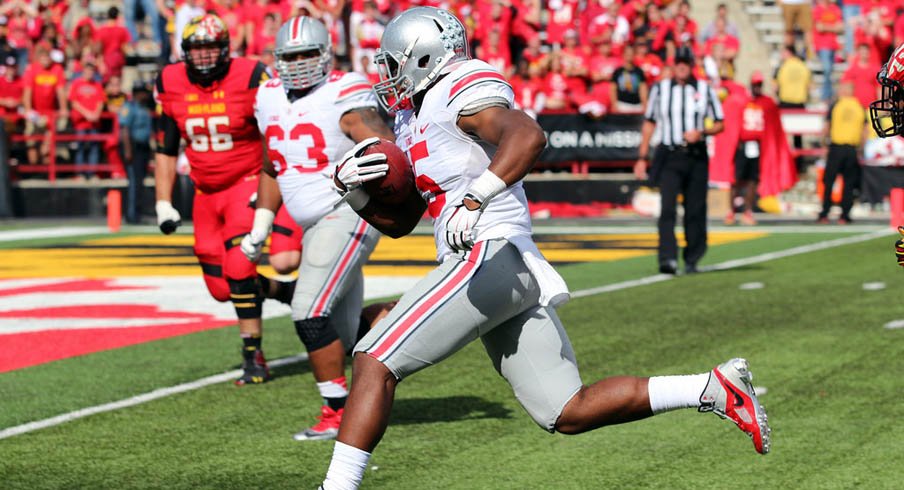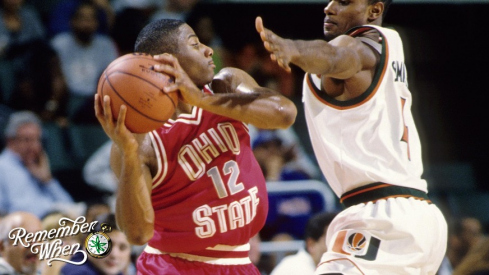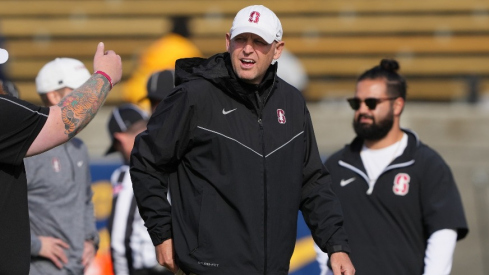Ohio State turned in its most complete performance this season in soundly defeating a solid Maryland team.
The Buckeyes controlled the game against the Terrapins by improving upon issues that plagued them in earlier games. The Ohio State offense largely conquered the bear, man coverage defense that caused them fits against Virginia Tech. And the Buckeyes were mostly sound in pass defense against good Maryland wide receivers, limiting big plays and getting off the field on third down. By also receiving critical special teams play from their kickoff and punt units, the Buckeyes were able to quickly establish a lead and keep the game out of reach.
Step by Step
On defense, Ohio State continued its improvement, largely keeping Maryland in check until the game was out of reach. The Buckeyes held the Terrapins to 310 total yards, including only three plays over 20 yards. And the biggest of those came in the fourth quarter when backup safety Cam Burrows failed to gain sufficient width in cover 4 against a smash concept.
The Buckeyes' success began up-front. Maryland was the first team this season that attempted a play action, drop back pass game against Ohio State. The Terrapins' goals was to try and replicate Cincinnati's success throwing downfield.
But in doing so, Maryland played into the Buckeyes' strength. Ohio State responded with three sacks and additional pressures.
Much of that pressure came from inside moves from end Joey Bosa and tackles Michael Bennett and Adolphus Washington. The Buckeyes liberally used their third down nickel package.
In this sub package, corner Armani Reeves enters in place of one of the defensive tackles. The other tackle bumps down to nose guard with the Buckeye defensive ends coming inside to five techniques. Walk-out linebacker Darron Lee then serves as a roving outside rusher. Reeves lines up in the wide flat, where he will either function as an underneath defender or will drop to the deep middle in Tampa 2 or cover 3 zone coverages.
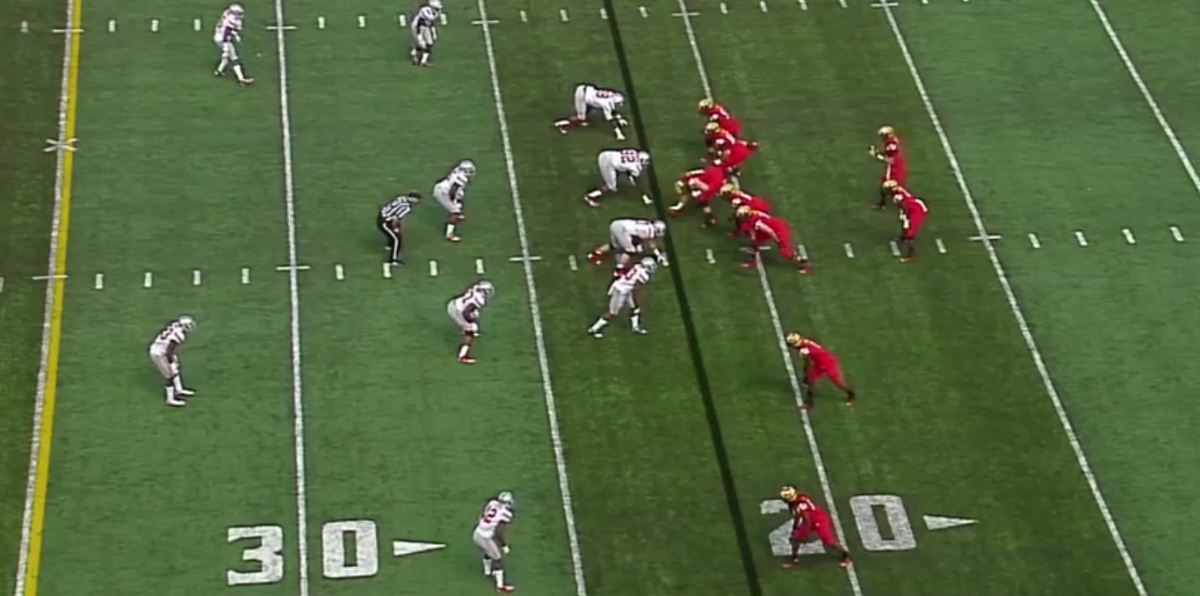
From this three man front, Bosa was given a two way go, allowing him to be particularly disruptive.
The Buckeye front so controlled the line of scrimmage that, by the middle of the second quarter, Maryland largely eschewed a running game and deep drops in favor of quick passing and wide receiver screens.
And the Buckeyes' play against Maryland's extensive screen game was further evidence of the defensive improvement under Chris Ash and his cover 4 defense.
This was the second straight week Buckeyes faced a strong screen team. And for the second week the Buckeyes did not allow their opponent to turn underneath throws into big gains, by correctly diagnosing, maintaining leverage, taking proper pursuit angles and tackling the football. Such fundamentals were too often missing last season.
Growth
That is not to say the Buckeye defense is where it should be. Maryland was able to gain several first downs in third and long situations in the second half, allowing the Terps to score two late touchdowns. And Ohio State's cover 4 defense left corner routes uncovered several times.
But members of Ohio State's young back seven continue to show improvement. Corner Eli Apple played very solidly after several breakdowns against the Bearcats. Lee had his best game, using his athleticism in space to make plays. And safety Tyvis Powell is extremely sound in the back end.
Several Buckeye defenders have also separated themselves from their teammates at their position. Safety Von Bell continues to evidence a nose for the football and use solid leverage, as opposed to Burrows, who looks slower in play recognition and response.
And freshman mike Raekwon McMillan has largely grabbed the position from Curtis Grant. For the second straight game McMillan played more snaps. McMillan is more sound against the pass. He also shows quicker recognition, which allows him to use his athleticism and flow to the football.
In short, the Buckeye defense continues to grow. It is difficult for offenses to combat the Ohio State strength, which is their defensive line. So teams will continue to throw quickly and try to catch the Buckeye back seven out of position.
In today's football it is unrealistic to entirely shut out the opponent, as even teams like Maryland and Cincinnati have players who can make plays in space. But if the Buckeye pass defense continues it current trajectory they will be in a solid position by season's end.
Deja Vu All Over Again
Another week, another bear, man coverage defense. By now, it must seem repetitive to the Ohio State offense, who have faced a steady diet of the look since Virginia Tech.
Maryland attempted the same approach. The Terrapins would frequently use a full bear front or a modified bear, with the wide side defensive end in a 4i (rather than 3 technique). Behind the front Maryland frequently used either cover 1 man with a very deep free safety or straight man cover 0, particularly in the red zone.
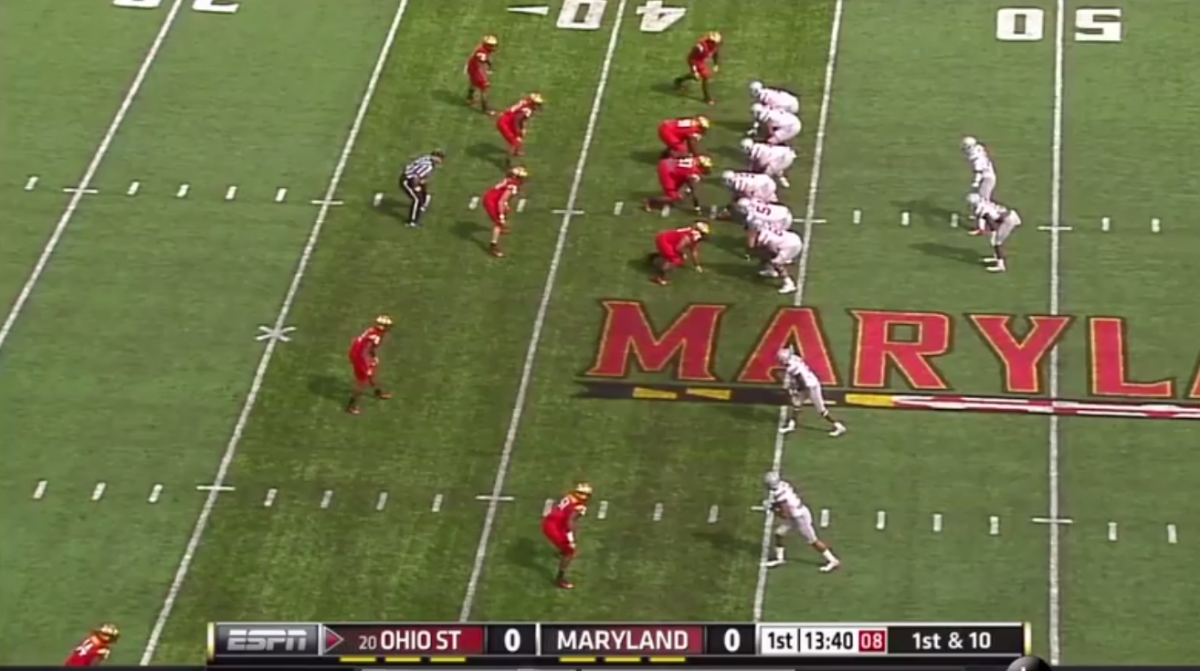
Unfortunately for Ohio State's opponents the Buckeye offense has quickly adapted to the look. As noted last week, the Buckeyes have added to their run game to combat such interior-heavy looks.
Upon seeing Maryland line up in the bear the first series Saturday, Ohio State immediately checked to a tackle power play. The front side blocked down the interior three defensive linemen, the tight end fanned blocked the outside linebacker and the tackle led through the playside C gap -- taking advantage of the Bear's natural bubble.
The Buckeyes also successfully utilized speed option, which is Urban Meyer and Tom Herman's first response to cover 0. The speed option was open against Virginia Tech, but J.T. Barrett did not understand that he needed to attack the option man until the second half against the Hokies, when it became too little too late. The Buckeyes' success with the play Saturday is further evidence of Barrett's quick growth.
To further combat Maryland's aggressive looks, Herman and Meyer utilized unbalanced and overloaded formations. Ohio State operated its touch pass and play-action from a tight-end covered trips.
Similarly, the Buckeyes responded to Maryland's man coverage with numerous trips' wide receiver formations. This forced the Terps to rotate their coverage, both limiting Maryland's force support and creating a crack back for Heuerman to open power read to the trips.
It's Not the X's and O's . . .
But schematic adjustments would be of limited value without improved execution. This begins with the offensive line. The Buckeye front five was not perfect. At times they missed combo blocks onto second level defenders, allowing Maryland to stop several run plays for little to no gain.
But the offensive line largely won against Maryland's interior defenders, enabling Ohio State's inside run game. The Buckeye offensive line also did a superb job in pass protection picking up the Terps' stunts and blitzes. They received help from Heuerman, whom the Buckeyes frequently kept in for pass protection to allow a full slide by the offensive line. Although the Ohio State line must prove they can handle more talented defensive linemen, they have demonstrated they can now adept to the fronts and games that were proving so difficult to start the season.
As important as the offensive line's improvement is the emergence of Ezekiel Elliot. Elliot demonstrates great vision -- the most important attribute for a running back. This is evidenced by how he finds holes compared to his fellow tailbacks (perhaps with the exception of Curtis Samuel). He then runs with forward lean, making him difficult to tackle.
But the Buckeyes' success against such aggressive defensive looks ultimately results from a more successful pass game. This begins with pass protection but extends to Barrett and his receivers. Devin Smith still presents a critical deep threat. But the Buckeyes are now receiving key contributions from Michael Thomas and Corey Smith. Thomas in particular has shown a knack to get open and then use his size to gain yards after the catch. And tight end Nick Vannett also presents a legitimate option.
As discussed, Barrett's quick growth is readily apparent. Throwing the receiver open is critical against man coverage, and Barrett is doing an excellent job anticipating throws and putting the football in spots where his receivers can make a play.
For instance, on Barrett's first touchdown throw, Maryland was in Bear cover 0. The Buckeyes ran a double-in and corner route. Barrett -- knowing he faced a blitz -- retreated for space and then threw the football to the corner before Jalin Marshall left his break where only Marshall could run down the football.
Those type of throws were open against Virginia Tech. But the Buckeyes simply could not hit them with the necessary success rate. The Ohio State offense will only improve (and force teams out of such looks) as Barrett and the passing game develop.
Get Ready, Cause Here it Comes
Teams will continue using this defensive formula because the key to the Buckeye offense is the inside run game. It is the base offense that sets up the horizontal plays constraint plays to the H and downfield passing game. If the Buckeye offense can run inside they are extremely difficult to stop. By contrast, as evidenced against the Hokies, when the Buckeyes cannot run inside they quickly become rudderless.
So opponents will continue to load the box -- even if it leaves them vulnerable in other areas. They would prefer to try and stop the Buckeyes' preferred method of attack than play cautiously against the Ohio State passing game.
And the bear still had some teeth for Maryland, providing Ohio State a certain amount of difficulty in goal line and short yardage by playing the front with cover 0. In response, the Buckeyes went tackle over to run their pistol inside zone play. But the Terrapins put more bodies at the point of attack then Ohio State had blockers. As Herman admitted post-game, he likely got too stubborn trying to run into such stacked fronts.
The Buckeyes will thus continue to see such looks going forward. But they have now demonstrated their adaptability. Going forward, they must continue to use blocking schemes to ensure they can run against bear fronts. And they must be able to throw to force teams out of the look, including in the red zone.
